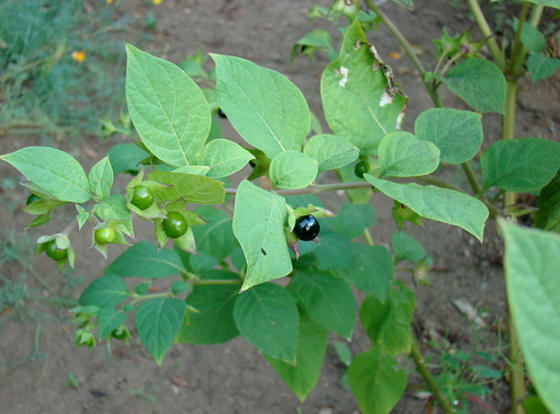BELLADONNA
ALKALOIDS
Belladonna alkaloids
are a group of plant-based compounds that affect the central nervous system. They are produced by the plant Datum stramonium, or Jimsonweed, and other closely related plants of
the nightshade family. The name
"Jimsonweed" comes from records of a famous poisoning that left the settlers of the Virginia
colony of Jamestown deathly ill.
Someone unfamiliar with the edible plants of the New World included the leaves
of this plant in a salad, resulting in severe intoxication in the diners. The plant became known as Jamestown weed,
which later was corrupted to
Jimsonweed. Teas prepared from any part of the plant, or the chewed seeds alone, produce a bizarre dream state
at extremely high doses. Most users do
not remember the experience because the drug causes amnesia. Ingesting doses large enough to produce this mental state
causes dangerous effects on heart rate, breathing, and body temperature.
The active agents in
Jimsonweed are the belladonna alkaloids atropine and scopolamine. Atropine is responsible for many
of the effects outside the brain. At
low doses, this compound or similar drugs are used to treat asthma and some stomach problems, and also to
diagnose eye problems. However, at higher doses atropine can be lethal. The
dramatic effects on thought and
perception are caused by the scopolamine. Scopolamine, unlike atropine, enters the brain easily and is
responsible for all of the behavioral
effects of this plant.
The belladonna alkaloids mimic the complete shutdown of the parasympathetic
nervous system—the mouth becomes dry, the pupils
dilate, the heart speeds up, the
bronchioles (breathing passages in the lungs) dilate, and digestion slows. These drugs also affect regions of the brain involved in the control of body temperature, which can rise to dangerous levels. Finally, they block one receptor for the neurotransmitter acetylcholine that is important for memory, so users
often don't remember the experience. These compounds and related ones also exist in other plants,
including the deadly nightshade (Atropa
belladonna) and the mandrake root (Mandragora officinarum). Used
properly, they are important and
effective medicines. They have also been used for
divin
Belladonna
alkaloids have very different actions from the serotoninrelated hallucinogens. They induce a bizarre
delirium that users remember only as strange dreams. These dreams often
include the sensation of
These compounds have been used throughout history,
as often for poisoning as for
hallucinations. The term belladonna, or "beautiful woman," comes from their use during the Middle Ages to
dilate the pupils of the eyes for the
enhancement of beauty. These drugs also were supposedly used by practitioners of female-deity worship in
Europe and Eurasia during the rise of
Christianity, when those using these drugs were depicted as "witches" by the early Church. These compounds were
used in medicine at the time, and it
is possible that famous stories of witches flying on broomsticks may derive from vaginal application of these drugs
to treat gynecological disorders. Recent news that criminals in Colombia drug tourists with "burundunga," a
plant-based drink containing scopolamine
that causes a dissociative state that the victims do not remember, proves that the historic uses of these plants
are still with us.

